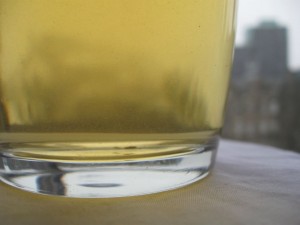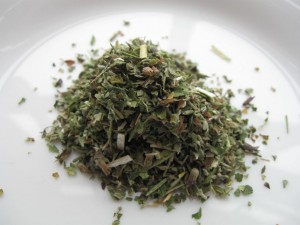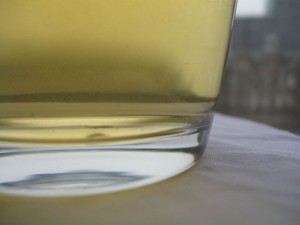Last updated: March 20, 2013
Catnip tea is a caffeine-free herbal tea made from the leaves of the catnip plant (scientific name Nepeta cataria).
People are often surprised that catnip can be made into a tisane because it’s much better known as cat attractant than as a herb. No-one is entirely sure exactly how catnip affects cats, but they certainly seem to love playing with it!
Catnip is in the Lamiaceae family, which is commonly called the mint family (catnip is even sometimes called catmint). This family includes common mints like peppermint and spearmint and other aromatic herbs like basil, rosemary and sage.
Catnip is native to Europe but is now grown all over the world.
Appearance
Catnip tea is made from the dried and chopped leaves and flowers of the catnip plant. The dried leaves are gray-green striped with thick white stems and stalks. The flowers and buds are tiny and very delicate. Catnip flowers range from bright white to blue to purple — the tiny buds in my tea are mainly purple.
How to make catnip tea
Catnip is a very delicate herbal tea. It’s important to not use water that’s too hot or leave it to infuse for too long or your tea will be unpleasant and bitter.
- Use one heaped teaspoon of dried tea for every cup of hot water.
- Heat your water to 80C (175F). Use a thermometer if you have one. If you don’t and you’re heating your water on the stove, take it off the heat just after tiny bubbles begin to form on the bottom of the pot. If you’re using an electric kettle, let it come to the boil and then leave it to cool down for around 6 minutes. (Neither of these methods will be very precise. You can get an instant read digital thermometer for less than $20 that will let you measure the temperature exactly. It will revolutionize the way you cook!)
- Pour the hot water over the tea and cover. Leave to infuse for 5-8 minutes.
- Pour and serve with any garnishes you like. A slice of lemon goes very well with catnip tea, as does a sprig of fresh mint.
Drinking catnip tea
Don’t use boiling water to make catnip tea. I did on my first attempt; the results weren’t great. The taste was a little minty and a little lemony but mainly bitter. Leaving it to infuse for anything longer than 5 minutes meant the bitterness completely overpowered all the other flavors. By using cooler water, I was able to infuse the tea for longer without spoiling the taste.
Color: after infusing for three and a half minutes, the color is pale yellow-green. After 5 minutes, the color is much the same. After 10 minutes, the color is a little deeper and stronger.
Aroma: grassy and sweet with a hint of citrus or lemongrass. As catnip tea infuses for longer, the aroma becomes stronger, the grassiness becomes less noticeable and the citrus intensifies until it smells like a little like lemon candy.
Taste: after infusing for 3.5 minutes the taste is slightly grassy and slightly minty with some astringency and a little saltiness. The tea is light and very fresh. There’s definitely some lemon in the aroma but there’s relatively little in the taste.
After infusing for 5 minutes, the taste is deeper and more substantial. There is still grass and mint but there are also floral notes I couldn’t detect before. The taste is refreshing more than anything else.
After infusing for 10 minutes, the flavor is more or less the same. The color is a little deeper, but I’m not sure I can taste anything I couldn’t before. Even after 10 minutes, there’s only the lightest hint of bitterness.

Catnip tea infused for 10 minutes. The color deeper but it tastes very similar to the 5 minute infusion.
When I first made this tea with boiling water, I really wasn’t a fan. It seemed like a pale imitation of other mint teas like lemon balm. The bitter notes were challenging in a way I didn’t enjoy. However, with a lower temperature of water catnip tea is really delightful. It’s definitely lighter in flavor than peppermint or spearmint tea, but it’s also more complex and more floral. I can definitely see myself incorporating catnip tea into my herbal tea rotation.
Benefits of catnip tea
Can you get a catnip tea “high”?
Catnip tea seems to have a reputation as a bit of a wild child in the herbal tea world. It’s common to see it described as “mildly stimulating”1 or words to that effect. Some people even seem to have the idea that catnip tea can make you “high” to some degree. Perhaps this rumour comes from the way catnip seems to make cats act strangely, but I can find absolutely no medical evidence to support the idea that drinking catnip tea will have any effect on your mental state whatsoever.
In fact, I can find virtually no mention of catnip or catnip tea and its effects on humans in the medical literature at all. Catnip tea has been used in the past as a home remedy, particularly as a mild sedative23. However, this effect has never been studied in a clinical setting and there is no evidence at all to support it.
Final thoughts
Catnip tea is a light, refreshing tisane that’s a complex, refined alternative to peppermint tea, spearmint tea or lemon balm tea. Just make sure you don’t make it with boiling water.


